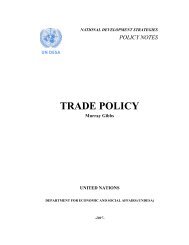Guidelines on the Safe Use of Urine and Faeces in ... - EcoSanRes
Guidelines on the Safe Use of Urine and Faeces in ... - EcoSanRes
Guidelines on the Safe Use of Urine and Faeces in ... - EcoSanRes
You also want an ePaper? Increase the reach of your titles
YUMPU automatically turns print PDFs into web optimized ePapers that Google loves.
Carol<strong>in</strong>e Schönn<strong>in</strong>g <strong>and</strong> Thor Axel Stenström<br />
Work<strong>in</strong>g <strong>the</strong> excreta <strong>in</strong>to <strong>the</strong> soil will m<strong>in</strong>imize fur<strong>the</strong>r human or animal exposure except for<br />
some soil-borne helm<strong>in</strong>ths, <strong>and</strong> will decrease <strong>the</strong> risk for pathogen run-<strong>of</strong>f to nearby waters. A<br />
withhold<strong>in</strong>g period between fertiliz<strong>in</strong>g <strong>and</strong> harvest, as suggested for ur<strong>in</strong>e above (Table 6), is<br />
recommended also for faeces. This will allow fur<strong>the</strong>r reducti<strong>on</strong> <strong>of</strong> pathogens due to ambient<br />
factors such as microbial activity, UV-light <strong>and</strong> desiccati<strong>on</strong>, thus add<strong>in</strong>g ano<strong>the</strong>r barrier aga<strong>in</strong>st<br />
disease transmissi<strong>on</strong>. This withhold<strong>in</strong>g period should to be at least a m<strong>on</strong>th.<br />
Figure 18. Squatt<strong>in</strong>g pans with ur<strong>in</strong>e<br />
separati<strong>on</strong><br />
Alternative use <strong>of</strong> ur<strong>in</strong>e<br />
<strong>Ur<strong>in</strong>e</strong> diversi<strong>on</strong> is generally recommended for practical reas<strong>on</strong>s ,even if <strong>the</strong> ur<strong>in</strong>e <strong>and</strong>/or <strong>the</strong><br />
faeces will not be used. <strong>Use</strong> <strong>of</strong> ur<strong>in</strong>e, c<strong>on</strong>centrated or diluted with water, is <strong>the</strong> best way<br />
to utilize <strong>the</strong> plant nutrients. If not favoured due to practical reas<strong>on</strong>s or cultural beliefs,<br />
alternatives opti<strong>on</strong>s exist. Additi<strong>on</strong> <strong>of</strong> ur<strong>in</strong>e to a compost (c<strong>on</strong>sist<strong>in</strong>g <strong>of</strong> food waste <strong>and</strong>/or<br />
faeces) usually has a beneficial impact <strong>on</strong> <strong>the</strong> compost<strong>in</strong>g process. From a study <strong>in</strong> Thail<strong>and</strong> it<br />
was shown that ur<strong>in</strong>e facilitated <strong>the</strong> compost<strong>in</strong>g process (<strong>on</strong>ly food waste <strong>in</strong>cluded) (P<strong>in</strong>sem &<br />
V<strong>in</strong>nerås, 2003). Most <strong>of</strong> <strong>the</strong> nitrogen will be lost but <strong>the</strong> phosphorous <strong>and</strong> potassium reta<strong>in</strong>ed.<br />
The hygienic quality <strong>of</strong> <strong>the</strong> compost will not be degenerated by <strong>the</strong> additi<strong>on</strong> <strong>of</strong> ur<strong>in</strong>e if <strong>the</strong><br />
compost c<strong>on</strong>ta<strong>in</strong>s faeces. The potential <strong>of</strong> achiev<strong>in</strong>g a higher temperature, due to <strong>the</strong> result<strong>in</strong>g<br />
adjustment <strong>of</strong> <strong>the</strong> C:N ratio will be beneficial for pathogen die-<strong>of</strong>f.<br />
Cultivati<strong>on</strong> <strong>of</strong> plants <strong>in</strong> direct c<strong>on</strong>necti<strong>on</strong> to <strong>the</strong> toilet is a better alternative than to soak<br />
away <strong>the</strong> ur<strong>in</strong>e <strong>in</strong>to <strong>the</strong> ground. Such a toilet has been c<strong>on</strong>structed <strong>in</strong> e.g. India with subsurface<br />
<strong>in</strong>filtrati<strong>on</strong> <strong>in</strong> comb<strong>in</strong>ati<strong>on</strong> with water for anal cleans<strong>in</strong>g (Calvert, 1999). In subsurface plant<br />
resorpti<strong>on</strong> systems, <strong>the</strong> ur<strong>in</strong>e fracti<strong>on</strong> may also be comb<strong>in</strong>ed with greywater use.<br />
Alternative use <strong>of</strong> faeces<br />
<strong>Use</strong> <strong>of</strong> faeces enables utilizati<strong>on</strong> <strong>of</strong> <strong>the</strong> additi<strong>on</strong>al nutrients <strong>in</strong> excreta that are not found <strong>in</strong><br />
ur<strong>in</strong>e. They also functi<strong>on</strong> as a soil c<strong>on</strong>diti<strong>on</strong>er. Inc<strong>in</strong>erati<strong>on</strong> <strong>of</strong> faeces yields an ash product that<br />
can be used as a fertilizer, which <strong>in</strong> some sett<strong>in</strong>gs may <strong>in</strong>crease <strong>the</strong> acceptance for use.<br />
30

















